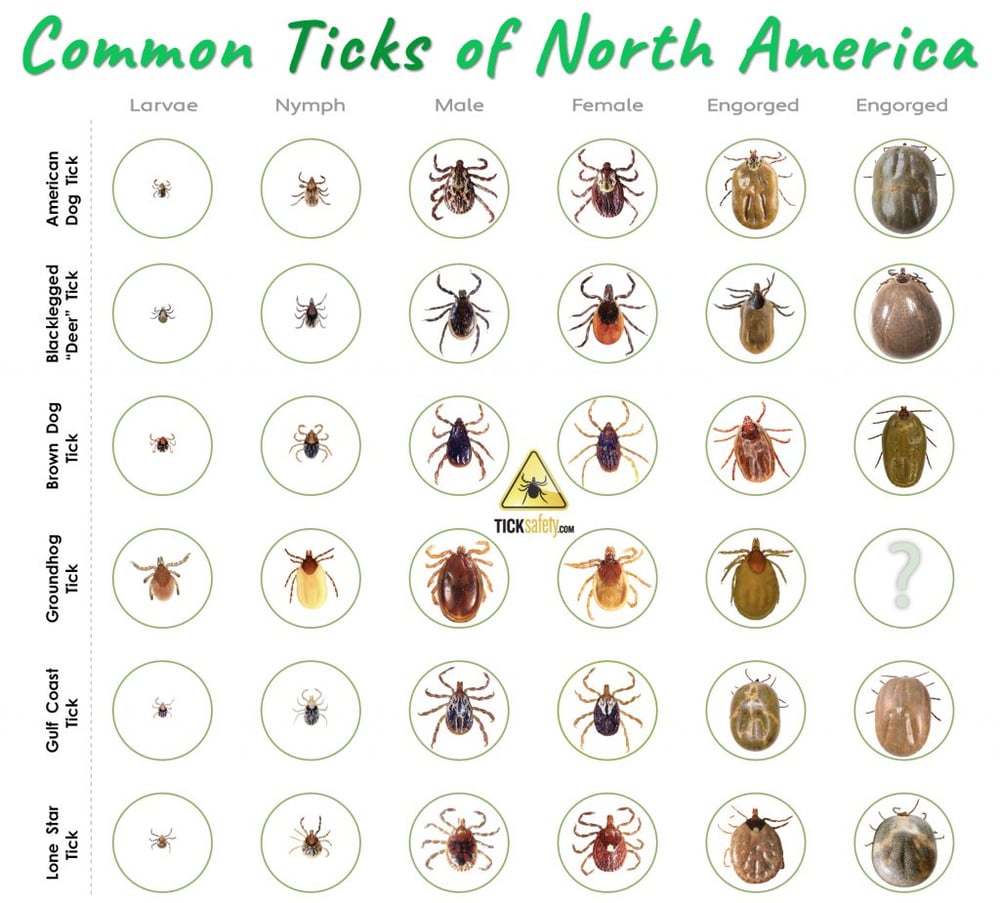 We all know it’s tick season when the flowers are starting to bloom, the snow has finally stopped falling (depending, of course, where in the country you live!), and, well, we’re all sneezing.
We all know it’s tick season when the flowers are starting to bloom, the snow has finally stopped falling (depending, of course, where in the country you live!), and, well, we’re all sneezing.
Spring has officially sprung! Which means it’s time to head outdoors and play in the grass with our pups!
But what does tick season mean for our beloved four-legged furry friends? Well, when we get bitten by a tick, we immediately know to remove it because,
- It’s irritating and causes inflammation in and around the area where the tick has bitten us, or to be more specific, where it has buried its head in our skin.
- Most of us know that ticks can carry various diseases that can be very detrimental to our health, and the longer they remain attached to us, the more likely they are to transmit these diseases.
But What About Dogs and Ticks?
What should we do if or when our dog gets bitten? Well, unsurprisingly, all of the above still applies. Just as with humans, when a tick bites a dog or a cat, it is just as irritating to their skin and will likely cause localized inflammation, swelling, and sometimes even infection.
And, just like humans, when a tick bites a pet, it can also transmit various diseases that can be very detrimental to their health.
However, you may have already surmised a major difference between most pets and humans is that they have a lot of fur! This makes finding ticks that much trickier, and pets don't talk to tell us there's something irritating their skin. So, we need to be proactive and vigilant. If you find a tick, you need to remove it right away!
Skip to section:
What Is a Tick-Borne Disease?
Ticks, apart from being not-so-attractive to look at and slightly creepy, may also harbor various diseases that can cause illness in dogs and cats, humans, and other mammals. Although these diseases don’t originate in the tick themselves, the ticks are responsible for spreading the diseases far and wide. Without the ticks, these diseases would have no way of spreading from animal to animal successfully.
The diseases that ticks are capable of spreading can be viruses, other parasites, bacteria, as well as other less common pathogens.
What is a host? In biology, the term host refers to an animal or plant on or in which a parasite or commensal organism lives. In the case of ticks, a dog, cat, person or another mammal is referred to as a ‘host’ because they are capable of ‘hosting’ the disease that a tick transmits to them. And furthermore, they are likely going to be affected by that disease.
How Do Ticks Transmit Disease to Dogs?
When an infected tick (a tick that is carrying a disease – and not all do) bites a host (any mammal), they are actually burying their head into and through that host's skin in order to feed on its blood to sustain itself (this is called a blood meal). At the same time that the tick is feeding on its host's blood and, if that tick is carrying any one of the tick-borne diseases (listed below), it is then able to be transmitted to the host via the host’s bloodstream.
Typically, a tick has to be attached to a host for a significant period of time — at least 24 hours for the transmission of a disease. If a tick has been attached for less than 24 hours, it likely will not have had enough time to transmit any disease. And, a tick that has not attached at all but was just found crawling on the skin or surface of the fur is not able to transmit disease. It must be attached to transmit disease.
If a tick has been attached for less than 24 hours, it likely will not have had enough time to transmit any disease to a person or dog.

Where Do Ticks Get the Diseases From?
Ticks acquire these diseases by feeding on ‘reservoir’ hosts (note, this is not the same as a regular host described above), such as white-tailed deer or small rodents. Reservoir hosts can be infected by a disease but not affected by it. So, when ticks feed on these hosts, they procure the disease and are then able to transmit it to the next mammal when feeding on their next blood meal. This is how these diseases are spread.
However, it must be noted! There are many different tick species in the U.S. (over 90!), and not all tick species carry every tick-borne disease, and not all tick-borne diseases are able to be carried by all the different tick species. It is species-specific.
To complicate the situation further, most tick species are capable of carrying multiple different diseases at one time! Provided it is compatible with those diseases.
Ultimately, it will depend heavily on where in the U.S. you are located as to which tick species and diseases you and your dog may be more likely exposed to.
Tick Identification
Below we list which ticks carry which diseases and where they are found in the U.S., as well as worldwide. Refer to this chart and this site for more information on ticks.

Tick-Borne Diseases in Dogs
Lyme Disease
Lyme disease is the most commonly known tick-borne disease in dogs. According to the CDC, it is also the most commonly reported vector-borne disease (disease transmitted through the blood) in the U.S. Check out the 2023 Lyme disease forecast chart for the U.S. and Canada.
It is caused by a bacteria known as borrelia burgdorferi. Even though it is considered zoonotic, Lyme disease is not transmissible via direct contact between animals or animals and humans. A tick must carry the disease from one infected individual to another.
If one pet or human in a household tests positive for Lyme disease, it is often recommended that all animals and humans living with them are also tested – given the likelihood is greater that they were all exposed to the infected tick(s) at the same time.
Just as in humans, Lyme disease can be very detrimental in dogs also.
Tick that carries Lyme disease: Black-legged tick (a.k.a. Deer tick)
Where deer ticks are found in the U.S.: Mostly across the Eastern United States
Where deer ticks hide: You’ll typically find deer ticks in shady, moist, ground-level areas
Where the deer tick likes to burrow:
When they burrow into dogs, they like to find warm, moist areas such as behind the ears or just below the entrance to the ear canal, around the eyes or lips, under the tail, in their armpits, and between the back legs in the inguinal region (groin area). However, ticks can be found anywhere! So don’t let this list limit your search!
Symptoms of Lyme Disease in Dogs
Symptoms of Lyme disease in dogs can be relatively non-specific, making diagnosis difficult. Typically, dogs do not develop a ‘bullseye’ target lesion on their skin, which occurs in people who are infected with Lyme disease.
Infected animals won’t typically display symptoms of the disease immediately. Symptoms usually appear around 2–5 months after the tick bite. And it is even possible for signs to develop much later! So, if your dog starts acting ‘off,’ tired, a little lame, or sore in the joints, or perhaps you notice some swelling around their joints or lymph nodes, having them tested for Lyme disease, whether you have or haven’t seen a tick on them is always a good idea.
Symptoms in dogs may include:
- Lameness, which may be shifting legs (i.e., a different leg may be affected at various times, a key sign in Lyme disease
- Fever
- Lethargy (tiredness)
- Loss of appetite
- Joint pain or swelling of the joints
- Enlargement of the lymph nodes
- Occasionally you may see vomiting and/or diarrhea
Additionally, only a small percentage of animals infected with Lyme disease (approximately 5–10%) will actually show symptoms of Lyme disease. This makes diagnosis much harder and also delays treatment.
Diagnosis and Treatment of Lyme Disease in Dogs
Diagnosis
Veterinarians are very well-versed in regard to Lyme disease, given its widespread nature. Your vet may start to develop a concern that your dog may have been infected with Lyme disease from the symptoms they are showing, as well as the observations you have provided. However, to confirm their suspicions, your veterinarian may run a serologic blood test to determine if your dog has any antibodies to Lyme disease, which is an indicator that your dog was exposed to the disease. However, it can have some shortcomings.
If your dog was exposed to the disease but has not yet developed antibodies (which can take up to 4–6 weeks), then they may test falsely that they don’t have the disease. Or, if your dog is infected but did not mount a large immune response and therefore did not develop enough antibodies to be detected on this test, they may also test falsely negative. As such, it is recommended to perform this test no sooner than 4 weeks after finding a buried tick on your dog and wait no longer than 8–12 weeks to test them after finding a tick, as the antibodies can wear off, and once again, your dog may test falsely negative for the disease if this occurs.
Since the serologic blood test has its shortcomings, why do veterinarians recommend this test? Because it’s a great first step. It’s relatively inexpensive, and it’s quick and easy. Additionally, it can rule in or out exposure to Lyme disease immediately. From there, you and your veterinarian can determine if more tests are warranted or if treatment should be started for your dog.
Treatment
The good news is, in most cases of Lyme disease, because it is caused by a bacteria, it can, and often is, successfully treated with antibiotics. Treatment is usually for 3–4 weeks to ensure clearance of the bacterium. Your veterinarian may also prescribe anti-inflammatories for joint pain and lameness.
If Lyme disease is not treated in time
Lyme Nephritis: Unfortunately, a serious yet less common consequence of Lyme disease infection that may occur is Lyme Nephritis. A medical term for inflammation of the kidneys. This condition may result in kidney failure.
The symptoms of Lyme Nephritis are very similar to those of Lyme disease and/or kidney failure. However, they are typically much more severe in nature and may include vomiting, excessive lethargy, increased thirst/urination, decreased appetite, and weight loss.
There is a higher incidence of Lyme Nephritis in Labrador Retrievers than in other breeds. That could be because of their popularity in the U.S., or it is possible that they are more susceptible. Research on this is ongoing.
Anaplasmosis (a.k.a. Dog Tick Fever)
Dog Tick Fever is similar to Lyme disease in that it is also caused by a bacteria (named Anaplasma phagocytophilum).
Tick that carries Dog Tick Fever: Black-legged tick (a.k.a. Deer tick)
Where Dog Tick Fever is typically found: In the U.S. — typically in the Northeastern states, the West Coast, and the Upper Midwest
Symptoms of Dog Tick Fever
As with Lyme disease, the tick must remain attached for at least 24 hours to transmit the bacteria to a dog. After which, it can take up to 1–2 weeks for noticeable symptoms to develop.
It is not uncommon for dogs that are exposed to Anaplasmosis (dog tick fever) to not develop any noticeable symptoms. As with Lyme disease, the symptoms may be non-specific, making diagnosis difficult and delaying treatment.
The most common symptoms of dog fever include:
- Decreased appetite
- Fever
- Lethargy (tiredness)
- Dehydration
- Less commonly
- Vomiting and/or diarrhea
- Lameness
- Bleeding from the nose (rare)
- Neck pain and/or seizures (rare)
Diagnosis and Treatment of Anaplasmosis (Dog Tick Fever)
Diagnosis
Again, as with Lyme Disease. Anaplasmosis is typically identified on routine serologic blood testing due to the non-specific nature of the symptoms — making a diagnosis without any test virtually impossible. And, just like Lyme disease, this test only detects antibodies (due to exposure to the bacteria) and not necessarily an active infection. Therefore further testing is almost always needed in these cases, particularly if your dog is displaying any of the non-specific symptoms.
Treatment
Because Anaplasmosis is caused by bacteria, it is treated with antibiotics. Typically, infected dogs will start to improve within 1–2 days of starting this medication. However, treatment is required for several weeks to ensure the infection is cleared.
Many dogs who test positive for Anaplasmosis never become ill or require treatment for the disease. And those who become ill and are treated have a good prognosis for recovery.

Ehrlichiosis (a.k.a. Canine Rickettsiosis, Canine Hemorrhagic Fever, or Canine Typhus)
This tick-borne disease is another tick-borne disease caused by a type of microscopic bacteria of which there are numerous species. The species which affect dogs are Ehrlichia canis and Ehrlichia ewingii, and less commonly, Ehrlichia chaffeensis.
Ehrlichiosis may also be transmitted via blood transfusion from an infected dog to an uninfected dog.
German Shepherds and Dobermans are more vulnerable to this disease than other breeds.
Tick that carries Ehrlichiosis: Brown dog tick (Rhipicephalus Sanguineous)
Where brown dog ticks are typically found:
It can be found worldwide, including every state in the U.S. It is considered the most widespread tick species in the world. However, the brown dog tick is more highly concentrated in the Southwest and Gulf Coast regions of the U.S. There are subsequently more cases of Ehrlichiosis found in these areas.
Where brown dog ticks hide:
These are the most common ticks found in yards, around homes, and even in kennels. They hind in cracks in cement, decking, etc., and unlike many other ticks, they can't jump or fly. They "lay low," and when they sense body heat, they crawl on up!
Where the brown dog tick likes to burrow:
They like to attach themselves to the dog's head, ears, back, axilla (between their shoulders), and between their toes.
Symptoms of Ehrlichiosis in Dogs
If a dog becomes infected with Ehrlichiosis, there are three stages of infection that vary in intensity; each stage has different symptoms and potential outcomes.
Stage One: This acute stage of infection typically occurs within 1–3 weeks post tick bite. This stage may last for 2–4 weeks, and symptoms include:
- Fever
- Sores in the mucus membranes (in the nose and gum area)
- Inflammation of blood vessels
- Bleeding disorders — particularly from the nose
- Bruising may be possible
- Bone marrow suppression leads to decreased blood cell counts
Stage Two: Also referred to as the subclinical phase. There are no noticeable symptoms at this stage. However, this stage can last for many years (even the dog's whole life!) A dog can be infected with the Ehrlichia bacteria, but symptoms of chronic infection are not yet detectable. In some cases, an infected dog may be able to clear the infection during this stage on their own. However, if the infection is not cleared, it will then progress to the third stage, the chronic stage, which is the most serious stage of infection.
Stage Three: This chronic and most serious stage can be fatal. Symptoms may include:
- Pancytopenia — extremely low red and white blood cell counts
- Pale gums — as a result of anemia
- Swollen lymph nodes (under the jaw, armpit, point of shoulder, groin, and behind the knee)
- Breathing difficulties
- Bruising — which may be more obvious in less-haired areas, such as the stomach or groin area. Bruising in dogs often appears more red/purple in color than it does in humans.
- Spontaneous bleeding — particularly from the nose and/or eyes
- Bacterial infections due to decreased ability to fight infection
- Lameness (inability to use one or more legs)
- Swelling of the legs and scrotum
- Coughing
- Confusion, disorientation, and behavior changes may occur
- Ophthalmic (eye) disorders
- Increased thirst and urination as a result of kidney damage
Diagnosis and Treatment of Ehrlichiosis
Diagnosis
Just as with the previous tick-borne diseases listed above, diagnosis can be achieved with a simple serologic blood test. As with the previously discussed diseases, this test can also have false negatives if the body has not had time to respond to the disease or the test was performed too early.
Ensuring the test is not performed too soon after infection or combining testing with routine blood tests to assess the quantity of red and white blood cells may help your veterinarian confirm the presence of Ehrlichiosis.
Treatment
Ehrlichiosis is a bacteria, so treatment is with antibiotics to clear the infection. Treatment typically lasts from 6–8 weeks. In stage one of the disease, treatment with antibiotics usually clears the infection completely without incident, similar to stage two. However, antibiotic treatment during this stage of infection will likely be extended to ensure the bacteria has been completely cleared. However, in the third chronic stage, although antibiotics may clear the initial infection, damage to other organs of the body has likely already occurred, and this often results in fatal consequences.

Bartonellosis
Canine Bartonellosis is perhaps less common than some of the other tick-borne diseases we’ve discussed. However, due to the serious nature of the disease in dogs, it is worth mentioning.
Bartonellosis is caused by a bacteria, of which there are at least 38 different species worldwide that can affect a range of different hosts! However, not all species of Bartonella will affect every host.
The most common species of Bartonella that are responsible for causing disease in dogs are:
- Clarridgeiae
- Henselae
- vinsonii berkhoffii
In 1993 the first dog was diagnosed with Bartonellosis and was also diagnosed with endocarditis (inflammation of the lining of the heart). Once within a host, Bartonella lives within the red blood cells and/or the endothelium (the first layer of cells that lines organs, cavities, and vessels.)
Ticks that carry Bartonella: Ixodes tick species, which includes the deer tick
Although most commonly transmitted via ticks, specifically the Ixodes species, it can also be transmitted by numerous other vectors, such as the sand fly, cat flea, human lice, rodent flea, etc., making it transmitted by more vectors than any other infectious agent.
Symptoms of Bartonellosis in Dogs
Due to the location of the bacteria (within the red blood cells and/or the endothelium), Bartonellosis in dogs can cause a wide range of symptoms. However, it must be noted that in some cases, the disease may go away on its own, and in these cases, symptoms may not be noticed in the first place and/or may not be that severe.
In persistent infections, an infected dog may initially show up at the hospital with a fever and/or epistaxis (bleeding from the nose) and/or possible leg lameness in the early stages of infection.
Symptoms in dogs may include:
- Lethargy
- Loss of appetite
- Nausea and/or vomiting
- Fever
- Muscle pain
- Lameness
- Bleeding from the nose (epistaxis)
- Swollen or painful lymph nodes, especially near the site of infection
- Altered brain function and seizures
- Irregular heartbeat
Diagnosis and Treatment of Bartonellosis in Dogs
Diagnosis
Obtaining an accurate diagnosis of Bartonella is not straightforward. There is no simple test to confirm that a dog is not currently infected as with the previously mentioned tick-borne diseases. More advanced specialized testing, such as PCR (polymerase chain reaction) or culturing of infected tissues (such as the lymph node, cerebrospinal fluid, or blood), as well as other tests (immunohistochemistry or serology), must be performed in order to obtain a positive diagnosis.
Ideally, more than one of these tests should be performed in conjunction with one another to confirm a diagnosis of Bartonellosis.
Treatment
Antibiotics are again the treatment of choice for Bartonellosis infection as it is also caused by bacteria. However, resistance has developed against some previously prescribed antibiotics, which has required medical professionals to alter the protocol for treatment to other more effective antibiotics or antibiotic combinations. There is no standardized protocol for treatment, and any treatment for Bartonella will typically be lengthy.
If Bartonellosis is left untreated
If the infection is left undiagnosed or untreated, Bartonellosis can result in inflammation of many different areas of the body, including the lining of the heart and/or the heart muscle, both of which can lead to cardiac arrhythmias (abnormal heart rhythms), inflamed lymph nodes as well as inflammation of the liver, the inside of the nose, blood vessels, brain and/or its lining. Bartonellosis can also cause inflammation in other tissues, including subcutaneous fat, joints, and eyes. The prognosis for a dog who develops any of these conditions due to untreated Bartonellosis is poor and could result in death.

Rocky Mountain Spotted Fever (RMSF)
Rocky Mountain Spotted Fever is another common tick-borne disease seen in dogs across North, South, and Central America. It is caused by the bacteria Rickettsia rickettsii (or R. rickettsii).
Ticks that carry Rocky Mountain Spotted Fever and where they are found:
Primarily the American dog tick (Dermacentor variabilis) as well as the Rocky Mountain wood tick (Dermacentor Andersoni), both of which can be found most commonly in the southeastern U.S. states.
In South America, the Amblyomma tick species are primarily responsible for transmitting R. ricketsii. The brown dog tick is responsible for transmitting this disease in some areas of Arizona and in Central America, particularly in Mexico.
Symptoms of Rocky Mountain Spotted Fever in Dogs
Dogs are highly susceptible to infection with R. rickettsii, whereas it is rarely diagnosed in cats.
Symptoms in dogs may include:
- Fever up to 105°F (40.5°C)
- Lethargy (tiredness)
- Decreased appetite
- Swollen lymph nodes
- Joint pain/lameness in multiple limbs
- Coughing or trouble breathing
- Abdominal pain or discomfort
- Vomiting and diarrhea
- Swelling of the face or extremities
- Changes to the blood cell counts (decreased platelets, increased white blood cell count)
- Less commonly:
- Neurological symptoms such as balance issues or weakness
- Bleeding from the gums or eyes (petechial hemorrhages)
- Vasculitis
- In untreated cases, biochemical abnormalities can occur, which often leads to death
Diagnosis and Treatment of Rocky Mountain Spotted Fever (RMSF) in Dogs
Diagnosis
Diagnosing this disease is based on noticeable signs and serological blood testing. If your dog has the classic symptoms of RMSF and there is high suspicion (especially if you are in an endemic area, e.g., southeastern U.S. and the other places listed above), your veterinanrian may recommend starting antibiotic treatment while waiting for test results to prevent prolonging the course of the disease and potential critical illness.
Treatment
R.ricketsii is a bacteria, so antibiotics are the treatment of choice, and a typical course of treatment is 10–21 days.
If Rocky Mountain Spotted Fever is left untreated
If a dog diagnosed with RMSF is not treated, they may suffer an increased risk for severe complications due to the disease. This includes but is not limited to vasculitis (inflamation of the body's vessels), neurological or kidney disease, and/or bleeding disorders, as well as possibly, death.
It is very important to have your dog evaluated by your veterinarian if you suspect they may have been bitten by a tick or could be suffering a tick-borne disease.

Babesiosis
Canine Babesiosis is NOT caused by bacteria, but rather by a protozoan (a microscopic single-celled parasite) called Babesia – of which there are over 100 species worldwide. Only a handful of these species are present in the U.S., and fewer of which can infect dogs.
- Babesia canis: a larger species of Babesia, transmitted by ticks, most commonly the Brown dog tick and the American dog tick.
- Babesia gibsoni: a smaller species that mainly affects Pit Bull terriers and can be transmitted if an infected dog bites another dog or from an infected mother to unborn puppies, as well as from blood transfusions from infected dogs. This is the most common Babesia in North America.
- Babesia conradae: a smaller Babesia species that seems to be isolated to California.
- There are several other species of Babesia that can infect dogs; however, they are much less common.
When a tick is responsible for the transmission of Babesia, the tick needs to stay embedded for at least 24–48 hours to ensure effective transmission. Once in the dog’s bloodstream, the Babesia invades their red blood cells.
Pit Bull terriers and Greyhounds seem to be most affected by Babesia.
Ticks that carry Lyme disease: Brown dog tick and American dog tick
It’s important to note that although the Brown dog tick prefers milder climates and is more common in the warmer months, they are able to survive indoors, and therefore able to survive year-round.
Symptoms of Babesiosis in Dogs
This disease invades the red blood cells, causing the destruction of the cells. It results in several symptoms, including:
- Anemia (low red blood cell count)
- Jaundice (yellow discoloration to the skin, whites of the eyes, and mucus membranes)
- Pale gums
- Petechial hemorrhages on gums (bleeding)
- Lethargy
- Decreased appetite
- Dark-colored urine
- Vomiting and weakness
- Less commonly: coughing, difficulty breathing, neurological issues, or kidney disease
Diagnosis and Treatment of Babesiosis
Diganosis
As with tick-borne diseases that are caused by bacteria, a diagnosis of Babesia may be made using a serology blood test to determine if there are antibodies in a dog's bloodstream. However, the exact species of Babesia will not be known this way as the antibodies may cross-react to multiple species.
A definitive diagnosis of Babesia can be made by direct visualization and identification of the parasite in a dog's red blood cells on a blood smear through a microscope.
Typically, early infections will have a large number of parasites identifiable within the red blood cells, whereas chronic infections or asymptomatic carriers may have very few, making identification difficult.
There are now more advanced tests available to diagnose Babesiosis, which may be recommended by your veterinarian.
Treatment
Unlike tick-borne diseases that are caused by bacteria, Babesia can’t as easily be treated by a single, simple antibiotic.
The most recent treatment protocols involve anti-parasitic and antibiotic medication. This is to help stop the parasite from reproducing, allowing the dog’s immune system to catch up and giving it an opportunity to clear the infection.
Some species of Babesia may be harder to treat than others, particularly B. gibsoni, which may require additional treatments and possibly a longer treatment period.
There are other less common treatments that may be used to assist with eliminating a Babesiosis infection if the current treatment protocol is ineffective. Your veterinarian will discuss options with you if necessary.
Approximately 50% of Babesia cases require blood transfusions due to the red blood cell destruction and resulting anemia.
Even though treatment will reduce the number of parasites circulating in your dog's bloodstream and will result in an improvement in symptoms, the infection itself may not be completely cleared, even if your dog appears to be improving or better. Dogs that are diagnosed with Babesiosis are typically considered permanent carriers of the disease.
Hepatozoonosis
This disease is also caused by a protozoan parasite similar to Babesiosis called a Hepatozoon. However, unlike Babesia, there are only two species of Hepatozoon that cause Heaptozoonisis in dogs. They are Hepatozoon americanum and Hepatozoon canis.
- Hepatozoon americanum (H. americanum) causes American Canine Hepatozoonosis (ACH) and is transmitted by the Gulf Coast tick. Ticks acquire the disease by feeding on an infected dog and remain infected for their entire lifetime. They are also able to pass the infection onto their offspring, causing endemic spread of the disease. A dog must eat the tick or eat an animal that has tick larvae inside of them.
- Hepatozoon canis (H. canis) causes Old World Hepatozoonosis and is transmitted by the Brown dog tick that gets its blood meal from a dog. Typically, younger dogs (less than 18 months of age) are more commonly affected by H. canis.
Ticks that carry Hepatozoonosis: Brown dog tick and Gulf Coast tick
ACH is the most common and debilitating form of Hepatozoonosis in dogs in the U.S. The disease has since spread north and east from the Gulf Coast of Texas, although it has been located sporadically in other areas of the U.S.
Even though both H. americanium and H. canis cause Hepatozoonosis, the course of the disease and the recommended treatments to clear the parasites vary.
Symptoms of Hepatozoonosis in Dogs
- Fever is often the first and most common symptom of ACH infection
- Lethargy (tiredness)
- Decreased appetite
- Weight loss
- Swollen lymph nodes (under the jaw, armpit, point of shoulder, groin, and behind the knee)
- Muscle/joint/bone pain and/or muscle weakness
- Limping and/or reluctance to move
- Pale gums
- Painful when touched
- Decreased muscles of the head (atrophy)
- Possible discharge from the eyes and nose
Diagnosis and Treatment of Hepatozoonosis in Dogs
Diagnosis
There is no test to rapidly diagnose exposure to Hepatozoonosis. However, your veterinarian will likely your dog's history of tick exposure, in addition to their symptoms, along with specific findings on blood tests, including anemia (low red blood cell count) and leukocytosis (increased white blood cell count). Additionally, elevated liver enzymes, decreased blood proteins, and elevated enzymes associated with muscle inflammation may inform the assumption of a possible diagnosis. From here, your vet will be able to run additional tests, including a PCR (polymerase chain reaction) test that can detect parasite DNA and/or evaluation of blood films, on which parasite containing leukocytes (white blood cells) may be present.
Additionally, a biopsy of the muscle tissue can be taken to obtain a definitive diagnosis of infection with H. americanium. This is a much more invasive procedure and may not always result in confirmation due to the wide distribution of the cysts within the muscles.
Additional abnormalities may be detected on further tests if performed or recommended by your veterinarian, such as x-rays, which may help confirm a diagnosis.
Treatment
Treatment of Hepatozoonosis will depend on the species of parasite that is causing the infection. Infection by either species is considered lifelong and cannot be cured; however, it can be managed.
Treatment for a dog infected by H. canis is typically easier than treatment for H. americanium. It involves a series of multiple injections with an antiprotozoal agent over several weeks to months. Occasionally, the dog will receive an oral antibiotic simultaneously. Symptoms typically resolve quickly with this protocol, and infected dogs rarely relapse.
Initial treatment for H. americanium involves multiple medications, including two antibiotics and an antiparasitic drug. Once symptoms have resolved, an infected dog will receive prolonged treatment with an additional antiparasitic medication. Treatment with this medication may last more than two years. If symptoms return after discontinuation of this medication, restarting is recommended.
Effects of delayed treatment
Although both infections are considered serious and dangerous, H. americanium is considered a more severe disease than H. canis, with more severe consequences, especially if left untreated.
Symptoms of H. americanium can come and go, so an infected dog may appear ill for a period of time and then appear to recover. This is important to note, as dogs that do not receive treatment for H. americanium may develop significant damage to both their kidneys and blood vessels, which may also be fatal in some cases.
Infection with H. canis typically causes a less severe reaction. Although the symptoms are largely the same, they are generally less severe in nature. Some dogs infected with H. canis may show no noticeable signs; however, blood tests may show anemia (low red blood cell count), and a physical examination by your veterinarian may reveal an enlarged spleen.
How Do You Know If a Tick Has Bitten Your Dog?
It can be difficult to know if your dog has been bitten by a tick, given the amount of fur they have as well as the non-specific symptoms that are associated with most of the diseases.
However, if your dog has a tick embedded in their skin, your dog will typically show signs that something is bothering them. You may notice them itching or scratching at the area more often or be sensitive to the touch in that spot. If you run your hands through your dog's fur, you may feel a bump that could be an embedded tick, which can range in size from approximately one millimeter (size of a pinhead) up to the size of a small marble.

You may notice a scab, indicating your pet may have been bitten by a tick that has since dropped off, or you may see red, inflamed skin resulting from the tick bite. If your dog is showing any of the symptoms described above in the various tick-borne diseases, you should have your dog examined by a veterinarian ASAP.
What Should You Do If You Find a Tick On Your Dog?
If you do happen to find a tick on your dog, and it is not attached, you should remove it before it can embed itself. If the tick is embedded (burrowing in their skin), removal should be attempted ASAP to prevent not only irritation to your dog’s skin and possible infection but, perhaps most importantly, the transmission of any parasites they may be harboring.
Ideally, a tick should be removed by a veterinary professional who understands how to remove it properly without causing additional harm or damage to your dog. If a tick is removed improperly, it may result in the tick's head becoming separated from its body, which is common when an attempt is made to remove an embedded tick improperly. If the head remains in your dog’s skin, it will cause inflammation, discomfort, and infection. It is also possible for the just the head of the tick to transmit disease to your dog. Therefore, it is important to ensure it is completely removed ASAP. If you can’t see a vet immediately, you don’t want to delay; attempt to remove the tick yourself.
If you are certain you removed the tick properly, monitor your dog for any symptoms listed in this article. You should alert your veterinarian, as they may recommend having your dog evaluated in a 1 to 3 weeks' time to ensure there have been no ill effects from the tick bite and/or to test for any tick-borne diseases.
However, the tick that you removed may not be the one that caused the disease! For example, you could have missed the tick that took hold and then fell off without you noticing. This is why saving the tick you removed (to bring to the vet) is always recommended. If you feel that your dog is exhibiting any suspicious symptoms, please have your dog evaluated by your veterinarian immediately.

How to Prevent Tick-Borne Diseases
As the age-old saying goes, "prevention is better than cure." And with some of these diseases, a cure is not always possible. So, it is imperative that your dog is being treated with an appropriate and effective tick preventative. This may be a topical or chewable product or perhaps even a collar that contains specific products designed to repel ticks. The idea is that these products will decrease the likelihood that your dog may be bitten by a tick and, therefore, dramatically reduces the chance that they may acquire any tick-borne disease. Read more about over-the-counter preventatives versus prescribed ones.
Preventing Lyme Disease in Dogs
Lyme disease can be prevented in dogs. There is a vaccine.
Vaccination maintains the level of antibodies against the Lyme disease bacterium. So, if your dog was to contract Lyme disease, their body can recognize the bacterium, attack it, and clear it quickly before it can cause much damage.
Unfortunately, this is the only tick-borne disease for which there is a vaccination currently available.
Whether you should vaccinate your dog comes down to many factors, including your pet's overall health, any other illnesses they have, and where in the U.S. you live. If Lyme disease is not prevalent in your area, avoiding ticks may be enough prevention. This is a conversation you need to have with your veterinarian, as they will know the prevalence of the disease in your area and can provide the best advice for you and your dog.
My Lyme Disease Story:
I have my own personal Lyme disease story. I had just moved to the USA, and Lyme disease and other tick-borne diseases do not exist in Australia. So, I had my Labrador Aimee on preventatives and vaccinated because I was living in Upstate New York, where the grass is tall, the hiking is great, and there are horse and hobby farms a plenty.
However, about a year into us living there, I noticed Aimee a little more sluggish than usual, she was older (11 ish years), so I didn't think much of it, she was also a little more tender when walking, but again, I thought perhaps she ran too much the day before, and it was her age.
Then, one night about 1–2 days after I noticed her sluggish behavior, she started vomiting like the exorcist in the middle of the night! I was so confused. She was not a typical Labrador that ate everything and anything in sight, so I doubted it was something she got into.
She also refused her breakfast the next morning (VERY unlike her — or any Labrador!). And I decided it was time she became my patient, not just my best sidekick.
We ran blood work on her, and what do you know, positive for Lyme disease!!
I hadn't even seen a tick on her, despite my best efforts to check her daily (sometimes multiple times).
I started her on antibiotics asap, and within 12 hours, my girl was back to normal. Happy, waggy, eating, no more vomiting!
Just goes to show even if you're a vet, your dog can still get a tick-borne disease!
After that, I stepped up my tick-checks, particularly after a day of being out in the woods or with the horses. I revamped her prevention and ensured she was vaccinated yearly. She never contracted another tick-borne disease and never developed any long-term issues as a result of her diagnosis.
Preventing All Other Tick-Borne Diseases
UNLIKE Lyme disease, there is no vaccination currently available for all the other tick-borne diseases. Tick control and decreasing your dog's exposure to ticks remain the most effective prevention against these diseases.
Due to the Brown dog tick’s ability to survive indoors, year-round tick-control preventative medication is strongly encouraged. By discontinuing these preventatives in the cooler months, we run the risk of our dogs being bitten by a tick and possibly contracting a tick-borne disease when we least expect it. We, unfortunately, can’t predict the weather, and when we have the occasional warmer day, bugs such as ticks are often out and about wreaking havoc.
Additionally, with Hepatozoonosis disease, given its unusual method of transmission, preventing or discouraging your dog from accessing and consuming prey that could contain the parasite is important. And breeding dogs that have contracted H. canis is discouraged as the transmission of the disease can occur via the placenta to puppies. This has not yet been reported for H. americanium but is considered plausible.
Preventing Exposure
With all the ticks and all the possible diseases, limiting exposure and checking your dog's fur after walks and hikes are key.
The fewer ticks your dog is exposed to, the less chance they have of contracting a tick-borne disease.- Limit the amount of time your dog is exposed to ticks or environments where ticks live
- Limit time in long grass or in areas where deer may reside
- Have your dog wear booties and jackets when appropriate for the weather
- Check your dog after every walk or hike that you go on that may harbor ticks (think anywhere there is grass or other animals, i.e., deer, horses, etc.). Ticks jump from below, usually waiting in tall grass, and climb up dog’s (and people’s) legs to get to the parts of the body where they want to “hang” out
Despite the scariness of these diseases, I hope you get out and enjoy the great outdoors safely together!





